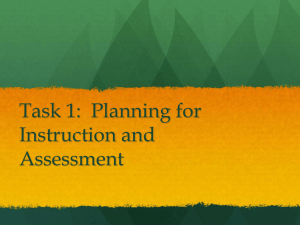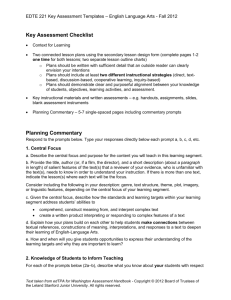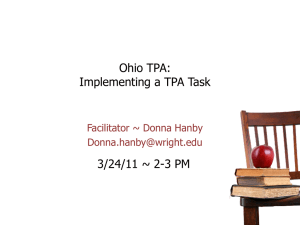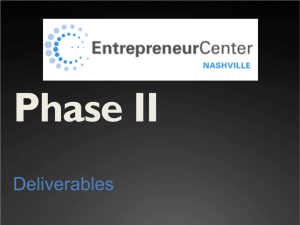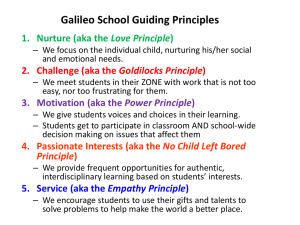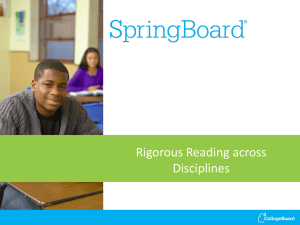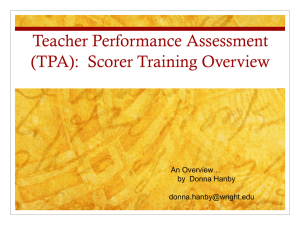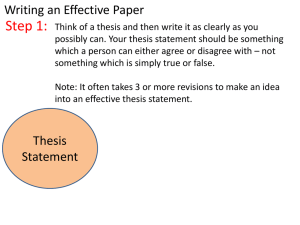An Introduction to TPA
advertisement
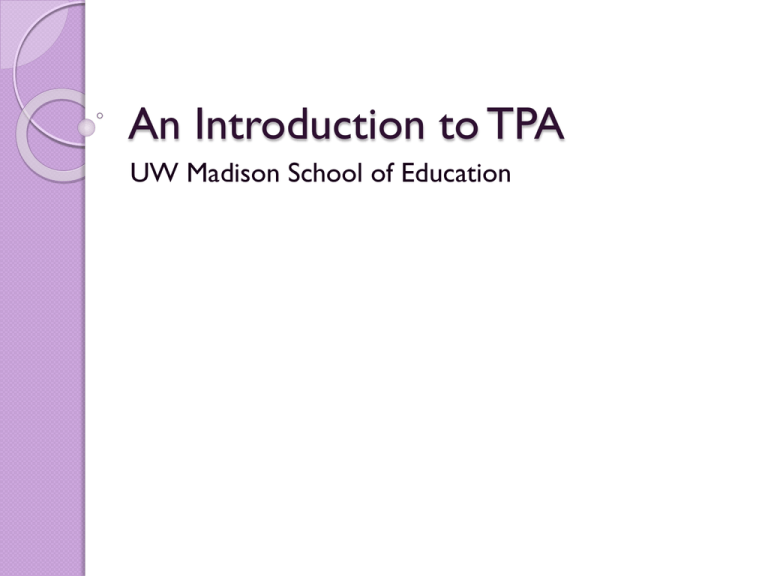
An Introduction to TPA UW Madison School of Education Major TPA Tasks 1. Planning, Instruction and Assessment 2. Instructing and Engaging Students in Learning 3. Assessing Student Learning 4. Analyzing Teaching Planning Context Analysis of Teaching -Students -Academic Language - Environment Assessment Instruction SO WHAT IS THIS ALL ABOUT? TPAC Task 1: Planning Instruction and Assessment Describe your instructional context. Select a learning segment of 3–5 sequential lessons related to the comprehension and/or composing of text Consider your students’ strengths and needs Create lesson plans and an assessment plan for the learning segment Explain what you know about your students and the rationale for the plans. Make daily notes about the effectiveness of your plan AKA – You will plan a series of 3-5 lessons Context for Learning Although considered a “regular education” science class, Fundamental of Biology is a class designed for students that may have difficulty in passing the Biology class. Although the students are able to self-select into the class, the placements are largely based upon teacher recommendations. Because the class is considered “regular education,” we are expected to maintain consistency with the content of regular biology classes, specifically to remain consistent with Wisconsin’s Model Academic Standards for Science. However, this is expected to be the last year that this class will be taught; my cooperating teacher teaches all three sections, and I have not experienced any top-down constraints regarding expectations for this learning segment. Sample Lesson Plan (Science) Essential Questions: What is cancer? What causes cancer? Big Ideas: Students will be recording five big ideas during the course of the learning segment. These will serve as reference points for students to make connections and ensure accountability for one’s own learning of the content. 1. A cell’s DNA regulates its growth and reproduction. 2. Cancer cells grow and reproduce in an uncontrolled way. 3. A cell becomes cancerous when several of the genes which control growth and reproduction become mutated. 4. 10% of the genetic mutations which lead to cancers are inherited 5. Exposure to carcinogens will increase the likelihood of developing cancer. Instructional Procedure Day 1: DNA is a regulator of cellular growth and reproduction Part 1: Regulation of Cellular Growth The class will be presented with the following idea: Every person in this class and every human in the world started as just one single cell. How did that one cell “know” to grow and divide in ways that over time would lead to a baby capable of surviving outside of the womb? To reinforce the idea behind this question I will show Video 1 (see the Resources section) depicting the process of an unfertilized human egg becoming fertilized and developing during the first eight weeks of pregnancy. The video will be muted so that students can interpret the images personally. I will then follow up with another related question: Additionally, after birth, how do the cells of a baby’s body “know” to grow and divide in ways that will allow that baby to grow into an infant, a small child, a teenager, and eventually a full-grown human adult? TPAC Task 2: Instructing and Engaging Students in Learning Collect permission forms from parents/guardians Video record segments of your lesson series Submit one or two clips from one lesson (no more than 15 minutes in total). Analyze your teaching and your students‟ learning in the video clip(s). AKA – Videotape and analyze your teaching Instruction Commentary In the second lesson, “Prove It: The Crafting of a Thesis Statement, I tried very hard to engage my students in the writing process. I explained to them that the thesis statement as the topic of the persuasive essay, needs to be concise and needs to be clear to the reader. After explaining the thesis statement, I began to demonstrate some possible topics that the students could write about. I have found from previous lessons that most of my students enjoy brainstorming as an entire class. Thus, in order to engage most of my students, I decided to lead the brainstorming and get them started about the topics for their essay. I have found that after a student gives an idea or suggestion, other students come up with ideas at an accelerated rate. If you watch my video closely, you will see many students excited about sharing and wanting their ideas to be heard. Instruction Commentary One of the ways that I accommodated for individual students is by allowing them to work individually or in small groups to write their thesis statements and evidence on note cards. In my video, you will see myself and other teachers walking around and assisting students TPAC Task 3: Assessing Student Learning Analyze whole class performance from one assessment task Identify three student work samples to illustrate trends in student understanding. Select and analyze the learning of two focus students in depth, and document your feedback to them. Reflect on your assessment process. Identify next instructional steps based on your analysis. AKA – Assess students and analyze their learning TPAC Task 4: Analyzing Teaching Using notes you have recorded throughout the learning segment, respond to commentary prompts to explain what you have learned about your teaching. Identify two or three things you would do differently. AKA – Reflect on the Lesson Series Final Commentary I feel that the lesson may have gone at too quick of a pace considering the nature of the learning objectives that I outlined. Specifically, I feel that ILO 6 was a massive undertaking and for which students were not adequately prepared. If I could implement this same learning segment again among the same students, I would chose to expand the length of the learning segment across 8-10 days of teaching rather than four. I feel that with that additional class time, I could utilize more strategies in allowing students to more effectively meet the segment’s six learning objectives. Final Commentary In retrospect, I should have taken more time to focus on the skills involved in ILO 6. I feel that I should have started at a more basic level in allowing students to build skills regarding the identification and interpretation of evidence. Part of the building process could have involved developing a language around which to communicate to each other about concepts relevant to developing those skills. This building process could have started with single paragraphs in which students could try to identify pieces of evidence, perhaps looking at whether or not cigarette smoke is carcinogenic. Students could compare what evidence one another came up with and we could use such discussions to develop a class-wide definition of evidence as well as a list of criteria for what types of information could serve as evidence. TPAC Academic Language in Literacy Select one key language demand related to the literacy central focus. Explain how you will support students with varied language needs. Cite evidence of opportunities for students to understand and use the targeted academic language. Analyze the effectiveness of your language AKA – Reflect on your use of language to support student learning
